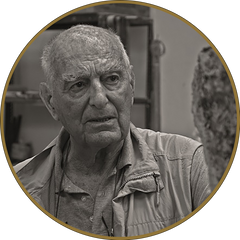Carlo Guarienti biography
- CARLO GUARIENTI PAINTER

Carlo Guarienti, born in Treviso in 1923, is an Italian artist known for his artistic journey characterized by a constant process of metamorphosis.
After earning a degree in medicine from the University of Padua in 1949, he approached art during the period he was called to arms between 1944 and 1945. During this time, he worked as a preparer of artistic anatomy at the Academy of Fine Arts in Florence.
Returning to his hometown in 1946, Carlo Guarienti began his artistic career creating still lifes, portraits, and significant artworks such as the San Girolamo, exhibited in 1947 at the exhibition of Modern Painters of Reality in Milan. This exhibition, organized by Gregorio Sciltian, Pietro Annigoni, and Antonio and Xavier Bueno, represented an important manifesto of the group opposing the abstract and informal art of the time.
Subsequently, Carlo Guarienti developed an artistic language moving towards a fantastic and visionary expression. During the 1960s, he experimented with an innovative technique inspired by the fresco tearing, using peeled plasters, cracks, collages, and synthetic resin mixed with color and sand. Influenced by artists such as Max Ernst and Aloys Zötl, he created a surrealist bestiary and later dedicated himself to painting mental geometries, pure forms, and rigorous perspective spaces.
In the 1980s, the artist focused on the representation of still lifes, self-portraits, and views. His artworks are characterized by suspended atmospheres, oscillating between reality and unreality, consistency and transparency. Carlo Guarienti demonstrates continuous research and experimentation in his artistic path, also exploring plastic production and printmaking, combining archaic models with twentieth-century suggestions.
The artist stands out for his complex poetics, based on a realism born from thought and translated into enigmatic images that float between dream and reality. His artworks are described as purely mental painting, an essential and purified dimension of pure thought, which distills and separates emotion. It is not mechanical and repetitive realism, but essential realism inspired by the great Italian pictorial tradition.
Carlo Guarienti's long career has been marked by numerous solo and group exhibitions in Italy and abroad. He exhibited his artworks in important galleries such as the Galerie Weill in Paris, the Galerie Claude Jongen in Brussels, and the Galleria del Naviglio in Milan. He also participated in significant artistic events such as the Venice Biennale, the Rome Quadriennale, and the Milan Biennale.
Besides painting, he collaborated on the creation of sets for Italian television and produced illustrations for Edizioni Curcio in Rome, including the work Il Purgatorio from 1966. He also produced an important graphic artwork, with numerous lithographs, serigraphs, and engravings.
Carlo Guarienti remains one of the leading representatives of the Italian figurative tradition of the twentieth century. His painting, characterized by essential realism and abstract thought, has left a significant mark on the contemporary artistic scene.



